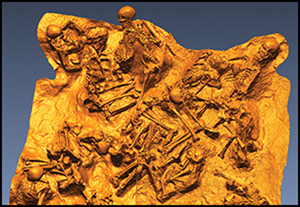Crossref Citations
This article has been cited by the following publications. This list is generated based on data provided by
Crossref.
Morton-Hayward, Alexandra L.
Thompson, Tim
Thomas-Oates, Jane E.
Buckley, Stephen
Petzold, Axel
Ramsøe, Abigail
O’Connor, Sonia
and
Collins, Matthew J.
2020.
A conscious rethink: Why is brain tissue commonly preserved in the archaeological record? Commentary on: Petrone P, Pucci P, Niola M, et al. Heat-induced brain vitrification from the Vesuvius eruption in C.E. 79. N Engl J Med 2020;382:383-4. DOI: 10.1056/NEJMc1909867.
STAR: Science & Technology of Archaeological Research,
Vol. 6,
Issue. 1,
p.
87.
Soncin, Silvia
Talbot, Helen M.
Fernandes, Ricardo
Harris, Alison
von Tersch, Matthew
Robson, Harry K.
Bakker, Jan K.
Richter, Kristine K.
Alexander, Michelle
Ellis, Steven
Thompson, Gill
Amoretti, Valeria
Osanna, Massimo
Caso, Marina
Sirano, Francesco
Fattore, Luciano
Colonese, Andre C.
Garnsey, Peter
Bondioli, Luca
and
Craig, Oliver E.
2021.
High-resolution dietary reconstruction of victims of the 79 CE Vesuvius eruption at Herculaneum by compound-specific isotope analysis.
Science Advances,
Vol. 7,
Issue. 35,
Ntasi, Georgia
Palomo, Ismael Rodriguez
Marino, Gennaro
Piaz, Fabrizio Dal
Cappellini, Enrico
Birolo, Leila
and
Petrone, Pierpaolo
2022.
Molecular signatures written in bone proteins of 79 AD victims from Herculaneum and Pompeii.
Scientific Reports,
Vol. 12,
Issue. 1,
Scorrano, Gabriele
Viva, Serena
Pinotti, Thomaz
Fabbri, Pier Francesco
Rickards, Olga
and
Macciardi, Fabio
2022.
Bioarchaeological and palaeogenomic portrait of two Pompeians that died during the eruption of Vesuvius in 79 AD.
Scientific Reports,
Vol. 12,
Issue. 1,
Squires, Kirsty
Hookway, Esme
and
Márquez-Grant, Nicholas
2023.
Don’t Forget the Children! A Review of the Consequences of Natural Disasters and Epidemics on Childhood Health and Mortality in the Past.
Childhood in the Past,
Vol. 16,
Issue. 1,
p.
57.
Petrone, Pier paolo
2023.
Burnt Human Remains.
p.
407.
Alapont, Llorenç
Gallello, Gianni
Martinón-Torres, Marcos
Osanna, Massimo
Amoretti, Valeria
Chenery, Simon
Ramacciotti, Mirco
Jiménez, José Luis
Morales Rubio, Ángel
Cervera, M. Luisa
Pastor, Agustín
and
Spekker, Olga
2023.
The casts of Pompeii: Post-depositional methodological insights.
PLOS ONE,
Vol. 18,
Issue. 8,
p.
e0289378.
Pensa, Alessandra
Giordano, Guido
Corrado, Sveva
and
Petrone, Pier Paolo
2023.
A new hazard scenario at Vesuvius: deadly thermal impact of detached ash cloud surges in 79CE at Herculaneum.
Scientific Reports,
Vol. 13,
Issue. 1,
Thompson, Tim J.U.
2023.
Burnt Human Remains.
p.
133.
Snoeck, Christophe
2023.
Burnt Human Remains.
p.
273.
Zhou, Yawei
Liu, Kailu
Yan, Fei
and
Berger, Elizabeth
2023.
Two cases of skeletal fluorosis from the historic cemetery at Zhangwan, Henan Province, China.
International Journal of Osteoarchaeology,
Vol. 33,
Issue. 6,
p.
1052.
Ktori, Maria
2025.
An Overview of Conservation Methods for Human Skeletal Remains Recovered in an Aquatic Context and Their Forensic Application.
WIREs Forensic Science,
Vol. 7,
Issue. 1,
Kalenderian, Vana
Thompson, Tim J.U.
De Looff, Deandra
Surtees, Alexander P.H.
Nowell, Geoff M.
El Haibe, Georges
and
Seif, Assaad
2025.
Written in ‘her’ bones: Cremation and identity in Roman Beirut.
Journal of Archaeological Science,
Vol. 177,
Issue. ,
p.
106153.
Thompson, T. J. U.
and
Nannetti, Antonia M.
2025.
A Burning Platform? Critical Reflections on the Impact of Research on the Developing Bioarchaeology of Cremation.
Journal of Archaeological Method and Theory,
Vol. 32,
Issue. 1,
